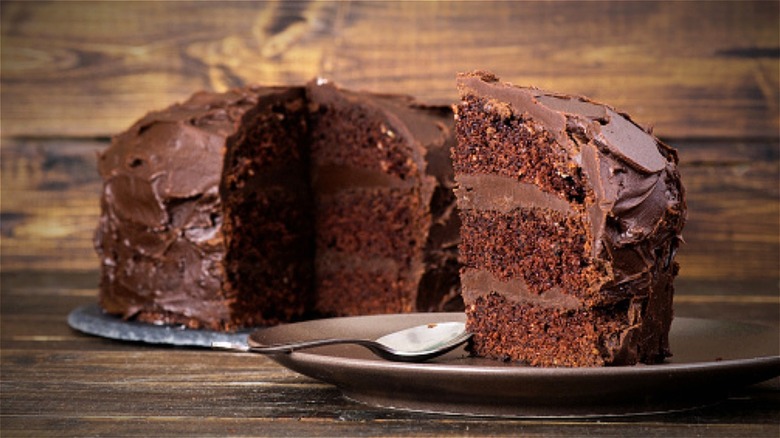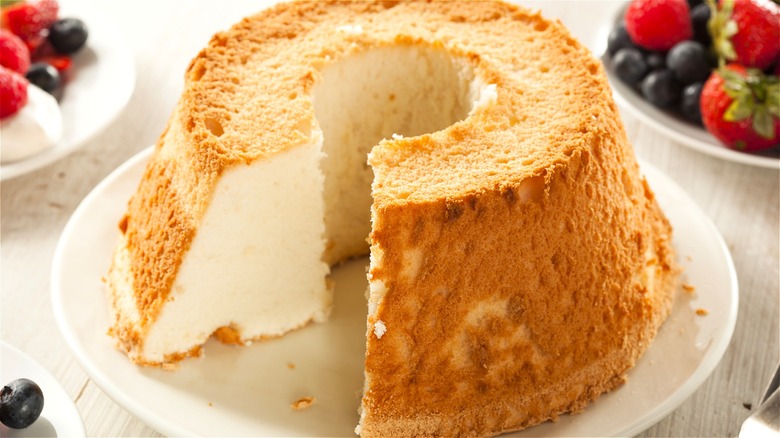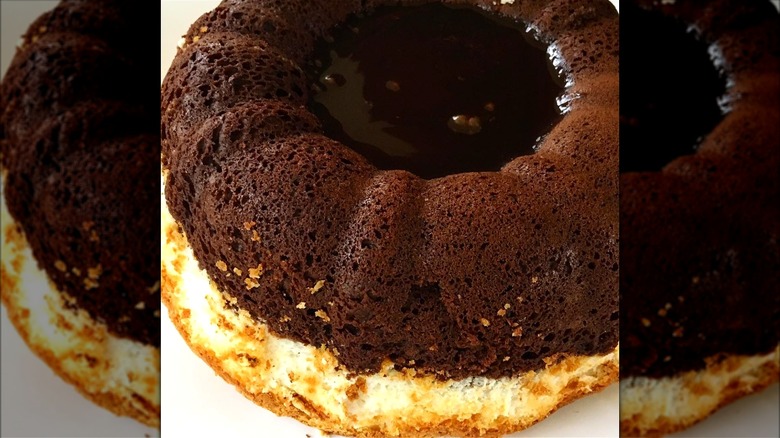What's The Difference Between Devil's Food Cake And Angel Food?
Most of us have witnessed a scene in a famous movie or comic book where a leading character makes a weighted decision with the help of a subconscious angel and devil to discern the moral truth. While fictional devils and angels may seem far-reaching in the food world, these terms can easily be used as descriptive words when categorizing the texture and flavor of some of our most beloved dishes. Just like salty is to sweet, and sharp is to mild, devil and angel are terms used to describe some of our favorite cake recipes. Angel food cake has a light and airy consistency, while devil's food cake is enhanced with the additions of unsweetened cocoa powder and extra baking soda, giving this baked dessert a rich color and texture.
Unlike sheet pan vanilla cake, which has a crowd-pleasing, nuanced flavor, devil's food cake and angel food cake serve as signature opposites in the world of confections. And these two confections couldn't be more different.
While angel food cake was developed in the late 1800s, the earliest recipe for devil's food cake was published in 1902. Devil's food cake was initially crafted from beets and cocoa powder and earned its title based on the categorization of certain foods in the 1700s that touted rich colors, spices, or added complexities.
What are the ingredient differences between angel food cake and devil's food cake?
Whether you're after a lusciously rich devil's food cake or a light and airy homemade angel food cake, the specific ingredients used for each of these varieties make them quite distinct from one another. If you often crave chocolate cake layered with decadent frosting, then devil's food cake may be the confection for you. While there are many variations of this cocoa-infused cake, most traditional recipes call for a combination of cocoa powder, coffee, sour cream, and water. What sets devil's food cake apart from other classic chocolate cake recipes lies in the amplification of that quintessential chocolate flavor. This treat earned its devilish name for its decadent (and often over-the-top) fudgy layers, which are often made complete with rich chocolate ganache frosting.
For those looking for a lighter dessert, look no further than classic angel food cake. This cloud-like confection is made with minimal ingredients yet touts an impressively soft yet sturdy composition due to whipped egg whites. Instead of relying on chemical leavening agents, angel food cake is generally made with up to 12 egg whites, flour, sugar, and no added butter or oil. You're left with an impressively springy confection that is light, spongey, and surprisingly fat-free.
And if you wish you could infuse both of these distinct cakes into one classic dessert, there's one cake recipe that will undoubtedly pique your interest.
How to combine the flavors of angel food cake and devil's food cake
For foodies looking to combine the classic flavors of vanilla and chocolate, vanilla chocolate chip cookies are always an option. But if you want to merge two entirely different cakes to create one remarkable dessert, you might want to consider combining devil's food cake and angel food cake. You can keep things simple and make half-recipes of both distinct cakes. Then, simply layer the light, spongy angel cake with the rich chocolate cake, with or without the addition of a simple frosting to hold the two confections together.
Alternatively, you can take this idea one step further and create a heaven-and-hell cake, which is essentially the best of both worlds. This cake was originally created by chef Stephan Pyles in 1993 and contains not only layers of angel food cake and devil's food cake, but also layers of peanut butter mousse and thick chocolate ganache.
If combining these iconic cakes feels like too much work, you can meet in the middle by topping your next homemade devil's food cake with an angel-like frosting of beaten egg whites, vanilla extract, and corn syrup. While devil's food cake tends to be richer and angel food cake has a more delicate flavor and texture, you can enjoy both of these popular desserts by finding a complementary way to fuse the contrasting cakes into one enjoyable treat.


